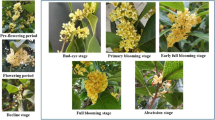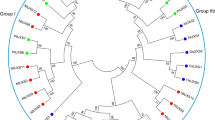Abstract
The enzyme tryptophan decarboxylase (TDC; EC 4.1.1.28) converts tryptophan into tryptamine. In Catharanthus roseus and other plants capable of producing terpenoid indole alkaloids (TIAs) TDC links primary metabolism to the secondary metabolic pathway involved in the biosynthesis of these compounds. The accumulation of tdc mRNA in C. roseus cells is developmentally regulated and transcriptionally influenced by elicitors (induction) and auxins (repression). Here we report that TDC is encoded by a single copy gene in the C. roseus genome. No introns were observed upon isolation and sequencing of this gene. To study gene expression controlled by the tdc promoter, a 2 kb promoter fragment and a number of 5′ deleted promoter derivatives were joined in translational fusion to a β-d-glucuronidase reporter gene (gusA). Expression of the chimaeric constructs was monitored in stably transformed tobacco plants and in transiently transfected tobacco protoplasts. Histochemical and fluorimetric analysis of transgenic plants revealed that 1938 by of the tdc promoter (with respect to the translational start codon) give rise to GUS activity in roots, stems and leaves. No tissue or cell type specificity was noted. Promoter deletions up to nucleotide −398 directed lower levels of gusA expression but conferred the same pattern of staining for GUS activity as the −1938 construct. Further deletion of the tdc promoter up to nucleotide −232 resulted in drastically reduced GUS activity levels and loss of GUS staining in all parts of the transgenic plants. In contrast to stable transformation, the −232 tdc-gusA construct gave rise to GUS activity levels comparable to those of the −398 construct in an assay system for transient expression in protoplasts. In this system the GUS activities measured were not affected by the presence or absence of the synthetic auxin naphthalene acetic acid (NAA).
Similar content being viewed by others
References
Ausubel FM, Brent R, Kingston RE, Moore DD, Smith JA, Seidman JG, Struhl K (1988) Current protocols in molecular biology. John Wiley and Sons, New York
Benton WD and Davis W (1977) Screening λgt recombinant libraries by hybridization to single plaques in situ. Science 196:180–182
Bradford MM (1976) A rapid and sensitive method for the quantitation of microgram quantities of protein utilizing the principle of protein-dye binding. Anal Biochem 72:248–254
De Luca V, Fernandez JA, Campbell D, Kurz WGW (1988) Developmental regulation of enzymes of indole alkaloid biosynthesis in Catharanthus roseus. Plant Physiol 86:447–450
Devereux J, Haeberli P, Smithies O (1984) A comprehensive set of sequence analysis programs of the VAX. Nucleic Acids Res 12:387–395
Feinberg AP, Vogelstein B (1984) A technique for radiolabeling DNA restriction endonuclease fragments to high specific activity. Anal Biochem 137:266–267
Geliebter J (1987) Dideoxynucleotide sequencing of RNA and uncloned cDNA. Focus 9:5–8
Gilmartin PM, Sarokin L, Memelink J, Chua, N-H (1990) Molecular light switches for plant genes. The Plant Cell 2:369–378
Goddijn OJM (1992) Regulation of terpenoid indole alkaloid biosynthesis in Catharanthus roseus: The tryptophan decarboxylase gene. Thesis Leiden University
Goddijn OJM, de Kam RJ, Zanetti A, Schilperoort RA, Hoge JHC (1992) Auxin rapidly down-regulates transcription of the tryptophan decarboxylase gene from Catharanthus roseus. Plant Mol Biol 18:1113–1120
Horsch RB, Fraley RT, Rogers SG, Sanders PR, Lloyd A, Hoffmann N (1984) A simple and general method of transferring genes into plants. Science 223:496–498
Jefferson RA (1987) Assaying chimeric genes in plants: the GUS gene fusion system. Plant Mol Biol Rep 5:387–405
Knobloch KH, Berlin J (1980) Influence of medium composition on the formation of secondary compounds in cell suspension cultures of Catharanthus roseus (L.) G. Don. Z Naturforsch 35C:551–556
Lam E, Benfey PN, Gilmartin PM, Fang R, Chua N (1989) Sites-pecific mutations alter in vitro factor binding and change promoter expression pattern in transgenic plants. Proc Natl Acad Sci USA 86:7890–7894
Maniatis T, Fritsch EF, Sambrook J (1982) Molecular cloning a laboratory manual. Gold Spring Harbor, Laboratory, Cold Spring Harbor, New York
Mattonovich D, Ruker F, da Camara MA, Laimer M, Regner F, Steinkellner H, Himmler G, Katinger H (1989) Efficient electroporation of Agrobacterium spp. by electroporation. Nucleic Acids Res 17:6747
Mettler IJ (1987) A simple and rapid method for minipreparation of DNA from tissue cultured plant cells. Plant Mol Biol Rep 5:346–349
Murashige T, Skoog F (1962) A revised medium for rapid growth and bioassay with tobacco tissue cultures. Physiol Plant 15:473–497
Pasquali G, Goddijn OJM, de Waal A, Verpoorte R, Hoge JHC, Schilperoort RA, Memelink J (1992) Coordinated regulation of two indole alkaloid biosynthetic genes from Catharanthus roseus by auxin and elicitors. Plant Mol Biol 18:1121–1131
Phillipson JD (1990) Plants as sources of valuable products. In: Charlwood BV, Rhodes MJC (eds) Secondary products from plant tissue culture. Clarendon press, Oxford, pp 1–21
Pröls M, Topfer R, Schell J, Steinbiss HH (1988) Transient gene expression in tobacco protoplasts: time course of CAT appearance. Plant Cell Rep 7:221–224
Sanger F, Nicklen S, Coulson AR (1977) DNA sequencing with chain terminating inhibitors. Proc Natl Acad Sci USA 74:5463–5467
Saul MW, Shillito RD, Negrutiu I (1988) Direct DNA transfer to protoplasts with and without electroporation. In: Gelvin SB, Schilperoort RA, Verma DPS (eds) Plant Molecular Biology Manual. Kluwer Academic Press, Dordrecht, pp A1/1-A1/16
Schulze-Lefert P, Dangl J, Becker-Andre M, Hahlbrock K, Schultz W (1989) Inducible in vivo DNA footprints define sequences necessary for UV light activation of the parsley chalcone synthase gene. EMBO J 3:651–656
Vieira J, Messing J (1982) The pUC plasmids, and M13mp7-derived system for insertion mutagenesis and sequencing with synthetic universal primers. Gene 19:259–268
Wink M (1988) Plant breeding: importance of plant secondary metabolites for protection against pathogens and herbivores. Theor Appl Genet 75:225–233
Author information
Authors and Affiliations
Additional information
Communicated by A. Kondorosi
Rights and permissions
About this article
Cite this article
Goddijn, O.J.M., Lohman, F.P., de Kam, R.J. et al. Nucleotide sequence of the tryptophan decarboxylase gene of Catharanthus roseus and expression of tdc-gusA gene fusions in Nicotiana tabacum . Molec. Gen. Genet. 242, 217–225 (1994). https://doi.org/10.1007/BF00391016
Received:
Accepted:
Issue Date:
DOI: https://doi.org/10.1007/BF00391016




